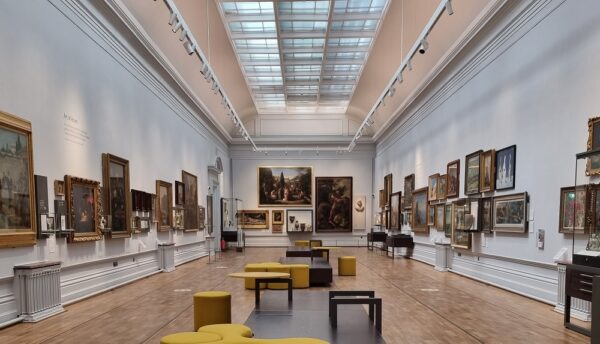
The Timeline of the Castle
Go to Nottingham City Museums

Nottingham Castle is known across the world as the backdrop for Robin Hood’s tussles with the dastardly Sheriff of Nottingham.
The Castle of today looks very different from its Hollywood depictions, and humble beginnings as a wooden motte-and-bailey fortification, however.
So, what really happened at this venerable old fortification? What truth lies behind the myths and legends? Nottingham Castle’s tale is one of Kings and Empresses, Lords and Governors, Dukes and ordinary people like you and me. Its great battles, heroic sieges, principled stands and the bravery to fight for what is right, rather than what is easy.
Everyone has heard of Robin Hood, but Nottingham Castle’s 1,000 years of history is packed full of influential and inspiring events. The Castle has seen it all – courage and cowardice, coups and conflict – since those first stones were laid on this storied old hill.

The foundation stones…
Norman Beginnings
In the years after the Norman Conquest in 1066, William, now King of England, began to assert his control over his new territory. He decided to build Nottingham Castle in 1068 – constructing a wooden motte-and-bailey castle.
Within 100 years a bloody civil war, The Anarchy, had broken out and Nottingham Castle was held by supporters of King Stephen. The Castle was besieged by Robert of Gloucester, Empress Matilda’s half-brother, and when Robert couldn’t capture the Castle, he plundered the town.


The Castle’s first capture
Norman Nottingham grows
Stephen’s army was defeated at the Battle of Lincoln in 1141 and Nottingham Castle was given up to Matilda. But two years later, William Peveril – the former constable of the Castle and supporter of Stephen – recaptured it. It is believed he upgraded parts of the complex with stone – building a large square tower in the upper bailey.
After the death of King Stephen in 1154, Henry II was crowned. Henry fortified the site with imposing stone walls and added many new buildings, including his favourite: ‘a house for the king’s falcons.’

Plantagenet Palace
Henry’s son Richard became the next king, but when he was captured in Austria, his brother John seized the throne. When Richard was released, he returned to England with an army and marched on John’s remaining supporters. One of John’s last strongholds was Nottingham, which Richard besieged in March 1194. He constructed a giant trebuchet to pound and hammer at the walls. The Castle’s garrison wisely surrendered before this intimidating weapon could be deployed, however.
Richard died a few years later and John was crowned king. John was forced by the lords and barons to sign Magna Carta, a document guaranteeing their rights and reducing those of the King. John further strengthened Nottingham’s defences and used the Castle as a treasury. John’s son, Henry III, again added to the Castle’s buildings by constructing twin towers to protect the outer gate. He left the Castle to fight in the Battle of Lewes, where he was defeated by the rebel Simon de Montfort, leading to a reform of royal power.
In 1327, after the death of his father Edward II in suspicious circumstances, 14-year-old Edward III was crowned King. Three years later, Edward’s supporters led a successful coup d’état against young Edward’s mother, Isabella of France, and her lover Roger Mortimer, who had been ruling as regents. The King’s raiders entered the Castle using the secret cave tunnel, now known as Mortimer’s Hole, which snakes up through the sandstone of Castle Rock. Mortimer was seized and later executed for treason. Edward remained fond of Nottingham and held parliament in the city on several occasions, passing important legislation around the sale of cloth and fur.
In 1397 Richard II commanded the deaths of the Earls of Arundel and Warwick here at Nottingham Castle. This would be a defining moment in the start of the Bollingbrooke rebellion, which would see Richard dead and Henry Bollingbrooke on the throne as King Henry IV. Henry gifted Nottingham Castle to his wife, Joan of Navarre, who built four windmills at Brewhouse Yard, affectionately naming them Sparrow, Donne, Dosse and Gloff.

A palace full royal
The Wars of the Roses
Neither Henry V nor his son Henry VI showed much interest in Nottingham, but in 1461, 18-year-old Edward, the Yorkist Earl of March, proclaimed himself King at Nottingham Castle during the Wars of the Roses. Later that year, after defeating both Jasper Tudor’s Lancastrian army and Henry VI’s forces, Edward was crowned king in Westminster Abbey. Edward appointed his brother, Richard, Duke of Gloucester – later Richard III – the commander of his armies in the north. These armies were based at Nottingham.


The fall of the House of York
From rebuilding to Bosworth
Between 1476 and 1480 Edward spent lavishly on Nottingham Castle, adding new comfortable State Apartments in the Middle Bailey and a defensive six-sided tower, known as Richard’s Tower. After Edward’s death, Richard devised a bloody path to the throne that involved killing off several family members. It was from his ‘Castle of care’ at Nottingham that Richard would raise his standard and depart for the Battle of Bosworth in 1485. At Bosworth, Richard, the last of the Plantagenets, was killed by the Lancastrians. They were led by Jasper Tudor’s nephew, Henry, who would become Henry VII, the first Tudor king.

Tudor decline
Under the Tudors, Nottingham Castle fell into ‘decay and ruin’. Henry VIII visited only once in 1511, the last time a monarch would stay at the Castle. Nottingham was regarrisoned during the Pilgrimage of Grace rebellion against Henry’s religious policies, but largely the Castle was forgotten until it was sold by King James I to the Earl of Rutland.

The standard raised
Civil War
On 22 August 1642, King Charles I raised his standard at Nottingham Castle – effectively declaring war on his own people and his Parliament. This act marked the beginning of the bloodshed of the British Civil War. Nottingham and its Castle were not Charles’ for long, and he quickly left after finding little support in the town. Nottingham became a stronghold for Parliament in a region dominated by those supporting the King.
The Castle’s governor, John Hutchinson, held the town throughout the war – despite several raids by Royalists from nearby Newark – even ordering the demolition of St Nicholas’ church, which had been used by invading troops to fire over the Castle’s walls.


Civil strife continues
Diaries and Death Warrants
Lucy, John’s wife, wrote a diary during the war and this intimate first-hand account of the Civil War has remained an important source for historians. She also acted as a nurse, tending to both wounded Parliamentarians and Royalists. Lucy’s Memoirs are now on display for you to see in our Rebellion Gallery.
By 1649 Charles had lost the war and would later lose his head too, with John Hutchinson being one of the signatories of his death warrant. Nottingham lost too. At the end of the Civil War, John ordered the demolition of what remained of Nottingham’s medieval Castle and walls hoping that they could never again be used militarily against the people of Britain.

Ducal palace
In 1663, after the restoration of Charles II, Nottingham Castle was purchased by William Cavendish, the Duke of Newcastle, who set to work clearing the site for the building of a Renaissance-style palace. It was completed in 1678 – after the Duke’s death – but it was regarded as one of England’s first and finest Italianate houses.

Disquiet ferments
The coming of the Industrial Revolution
But Nottingham changed too. No longer a small provincial town, it had become an industrial centre and a hotbed of simmering unrest. The smog-filled streets of industrial Nottingham lessened the Castle’s appeal. The last Great Ball was held in 1776 and the Dukes moved to more secluded palaces like Clumber Park. For the next fifty years, the Palace became a boarding school and then later apartments, including for the inimitable Miss Kirkby and her pet ape. Although the grounds were let out as allotments, the palace remained a resented symbol of power and oppression in the town.


The palace torched
A rousing of the rebels
By 1831 Nottingham had become infamous for its squalor and was home to some of the worst slums in the Empire. The Castle was owned by Henry Pelham Clinton, the fourth Duke of Newcastle, who left it vacant. He was a vehement opponent of electoral reform and led the defeat of a bill to extend the vote to more people and end corrupt voting practices. When news reached Nottingham that the bill had been voted down, the town erupted into furious riots. Houses and shops were attacked, and the Castle – that symbol of oppression on the hill – was stormed by a mob. The remaining furnishings were stripped, statues destroyed, and a great fire lit in the basement that burned the entire building. The people of Nottingham watched as the palace lit up the sky like a giant bonfire. As a silent rebuke to the town, the Duke left the ruined shell of the building un-repaired for 45 years.

The Castle Museum
In 1875, after reaching an agreement with the sixth Duke, architect T.C. Hine was tasked with renovating Nottingham Castle and turning it into a Museum of Fine Art. This work was completed in 1878 and the Castle became the first municipal museum of art in the country. Opened under the stewardship of curator George Harry Wallis, the museum was designed to inspire the creative and curious imaginations of the people of Nottingham, which by this time had become a world-leader in the design and manufacture of lace. The public art gallery sparked inspiration for pattern designers and other artisans in the town’s industries. Luckily, the Castle survived a potential second arson attack in 1913, when Suffragette bomber Eileen Casey was arrested in Nottingham with a hatbox full of explosives. The Castle was one of her possible targets.
In World War Two, the Castle was requisitioned by the Army and used as a lookout station and stores. An anti-aircraft gun was sited on the Middle Bailey and the Lower Bailey was converted into growing space for the war effort. Again, allotments were introduced that were tended by Italian prisoners of war from the camp at nearby Colwick.
Since 1878, the Castle has been a museum for Nottingham and its community. Its collection includes world-class examples of Nottingham alabaster, salt-glazed stoneware and Nottingham’s world-famous lace. It also showcases artworks by local and internationally renowned artists like Richard Parkes Bonington, Paul Sandby, Dame Laura and Harold Knight, Winifred Nicholson, Evelyn Gibbs, Magdalene Odundo, Zanele Muholi and Edmund de Waal.
In 2021 a new chapter of the story will be written, as Nottingham Castle re-opens following an extensive £30 million upgrade. The exciting new facilities will help to spread and safeguard the stories of Nottingham, Robin Hood and the Castle for generations to come.

